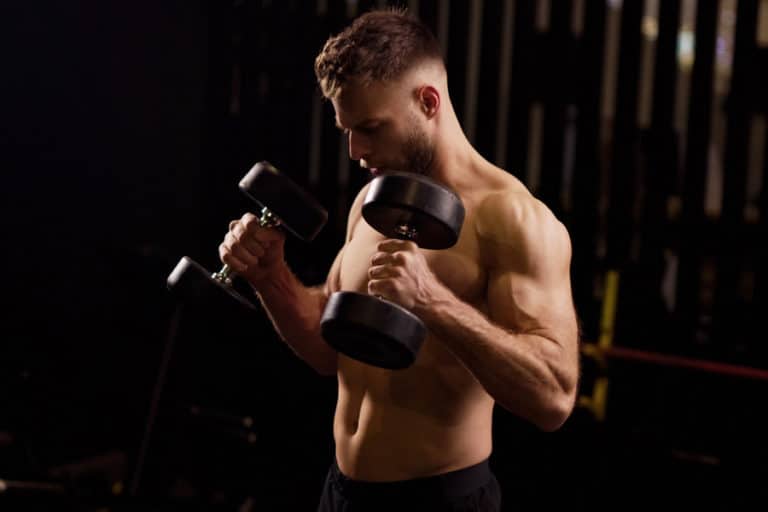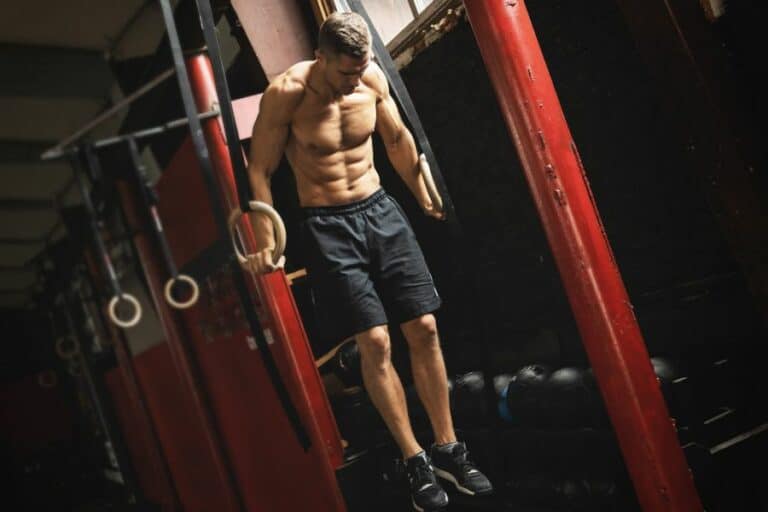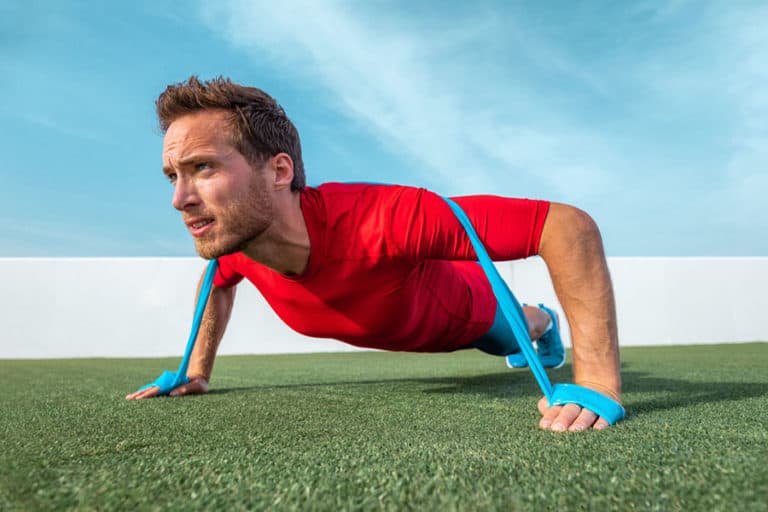Dumbbell Lat Workout: 10 Best Exercises For A Sculpted Back

Overview | 10 dumbbell lat exercises | Sample workout plan | Benefits
The latissimus dorsi, commonly called “lats,” are the broadest muscles in the back, located on either side of the spine.
A well-planned dumbbell lat workout routine can help sculpt and power up your lats.
Lats: An overview
The latissimus dorsi [1]National Library of Medicine: Anatomy, Back, Latissimus Dorsi muscles, the large flat, wing-shaped muscles in the lower back (posterior thorax region), are commonly called the “lats.”
Lat muscles attach to the back of the upper arms and run along the length of the spine from the mid to lower back. These play a crucial role in shaping the upper body and providing strength.
Functions of the lat muscles
The primary function of the lats is to pull the arm down and back around the shoulder joint. They also assist in rotating the shoulders inward.
Being so, the lats are essential in many daily activities that involve pulling. Activities such as lifting heavy objects, doing chin-ups or pull-ups, and rowing exercises require the engagement of the lats.
How to target the lats with dumbbells?
To effectively target the lats with dumbbells, it’s important to use rowing motions with your elbows close to your sides.
When performed with the elbows tucked, the pulling movement engages the lats instead of the upper back.
Top 10 dumbbell lat exercises
Working those lats with dumbbells can help you build a strong and powerful back. The importance of strong and functional back muscles can’t be overstated.
Here are some of the best dumbbell exercises for a sculpted back:
1. One-arm dumbbell rows
Target Muscles: Latissimus dorsi (lats), rhomboids, trapezius, biceps, and forearm muscles.
How To Do:
- Begin by standing with your feet shoulder-width apart, holding a dumbbell in one hand.
- Place your opposite hand on a bench or other sturdy surface for support.
- Hinge forward at the hips, keeping your back flat and your abs engaged.
- With your working arm, pull the dumbbell up towards your ribcage, keeping your elbow close to your side.
- Pause at the top of the movement, squeezing your shoulder blades together.
- Lower the dumbbell back down to the starting position and repeat for the desired number of reps.
- Switch arms and repeat the exercise on the other side.
Summary: The one-arm dumbbell row is an effective exercise for targeting the lats and other upper body muscles. It can be performed with a variety of dumbbell weights and can be easily adjusted for different fitness levels. Remember to maintain proper form throughout the exercise and avoid jerking or swinging the weight for the best results.
2. Dumbbell seal row
Target muscles: Lats, biceps, rear delts, rhomboids, and traps.
How to do:
- Lie face down on a flat bench with your legs straight and feet on the floor, holding a dumbbell in each hand with an overhand grip and palms facing each other.
- Keeping your elbows close to your sides, row the dumbbells up towards your chest, squeezing your shoulder blades together at the top of the movement.
- Lower the weights back down to the starting position and repeat for the desired number of reps.
Summary: The dumbbell seal row is a challenging exercise that targets the lats and other back muscles. By lying face down on a bench, you remove momentum and isolate the muscles to create a more intense workout.
3. Pendlay row
Target muscles: Lats, rhomboids, traps, erectors, and biceps.
How to do:
- Stand with your feet shoulder-width apart and the dumbbells on the ground in front of you.
- Hinge forward at the hips while keeping your back straight, and grip the dumbbells with an overhand grip.
- Row the dumbbells up towards your chest, keeping your elbows close to your sides and squeezing your shoulder blades together at the top of the movement.
- Lower the weights back down to the ground and release your grip, allowing the dumbbells to come to a dead stop.
- Repeat for the desired number of reps, starting each rep from a dead stop on the ground.
Summary: The Pendlay row with dumbbells is a variation of the classic Pendlay row that allows for a greater range of motion and more isolation of the back muscles. By starting each rep from a dead stop on the ground, you remove momentum and force your muscles to work harder. This exercise is effective for building strength and muscle mass in the back.
4. Kroc row
Target muscles: Lats, rhomboids, and traps.
How to do:
- Place a dumbbell on the ground next to a bench or other sturdy surface.
- Position yourself next to the bench with your feet shoulder-width apart and your knees slightly bent.
- Brace yourself against the bench by placing one hand on it’s surface.
- Reach your other hand down and grasp the dumbbell with an overhand grip, keeping your back flat and your head in a neutral position.
- Pull the dumbbell up towards your torso in a rowing motion, keeping your elbow close to your side.
- Slowly lower the dumbbell back down to the ground in a controlled manner.
- Repeat the exercise for the desired number of repetitions, then switch sides and repeat with the opposite arm.
Summary: The Kroc row is a challenging dumbbell exercise that involves lifting heavy weights for high reps. It is named after Matt Kroczaleski, a powerlifter who used this exercise to build his upper back and lat strength. The Kroc row is a great exercise for those who want to build strength and size in their upper back muscles.
5. Dumbbell renegade row
Target muscles: Lats, upper back, trapezius, and core.
How to do:
- Start in a high plank position with your hands gripping the dumbbells, your arms straight, and your feet shoulder-width apart.
- Engage your core, and while keeping your hips square, lift one dumbbell towards your ribcage by bending your elbow and pulling your shoulder blade back.
- Pause for a second at the top of the movement, then lower the dumbbell back down to the ground in a controlled manner.
- Repeat the movement with the opposite arm.
Summary: Renegade row is a challenging exercise that targets multiple muscle groups simultaneously, making it an efficient addition to any workout routine. To ensure proper form, keep your core engaged and your hips square throughout the movement. Start with a lighter weight and focus on maintaining proper form before progressing to heavier weights
6. Dumbbell spiderman rows
Target muscles: Lats, anterior deltoids, and biceps muscles.
How to do:
- Start by placing the dumbbells in front of you on the floor.
- Get into a plank position and grip the dumbbells with both hands.
- Begin the movement by bending your right elbow and explosively pulling the dumbbell up towards your right side, keeping it close to your body.
- Simultaneously lift your right knee towards your right elbow, mimicking spiderman’s climb or crawl. Pause briefly.
- Slowly lower the dumbbell back and simultaneously return your right leg to the starting position.
- Switch legs and arms and repeat the exercise.
Summary: The dumbbell spiderman rows are a great addition to any workout routine aimed at building upper abs and biceps. When performing this exercise, it is essential to maintain proper form and control the weight to avoid injury.
7. Dumbbell bench press
Target muscles: Lats, pecs, anterior deltoids, and triceps.
How to do:
- Lie flat on a bench with your feet firmly planted on the ground.
- Hold the dumbbells at chest level with your palms facing away from your body.
- Take a deep breath, brace your core, and press the weights up above your chest until your arms are fully extended.
- Pause briefly at the top of the movement, then slowly lower the dumbbells back down to chest level.
- Repeat for the desired number of reps.
Summary: The dumbbell bench press is a popular exercise for building chest and upper body strength. It is performed by lying on a bench and pressing the dumbbells up above the chest, then lowering them back down. This exercise primarily targets the chest muscles, but also involves the shoulders, back, and triceps.
8. Dumbbell reverse fly
Target Muscles: Lats, deltoids, rhomboids, and trapezius.
How to Do:
- Start by standing with your feet shoulder-width apart, knees slightly bent, and core engaged.
- Hold a dumbbell in each hand, palms facing inwards, and bring your arms in front of your body.
- Keeping your back straight, bend forward at the hips until your torso is parallel to the floor. Make sure to keep your head up and your gaze forward.
- With a slight bend in your elbows, lift both arms to the sides until they are parallel to the floor. Exhale as you lift the weights.
- Pause for a second, then slowly lower the weights back down to the starting position. Inhale as you lower the weights.
- Repeat for the desired number of repetitions.
Summary: The dumbbell reverse fly is a great exercise to target the major back muscles. Strengthening the upper back muscles can lead to better posture [2]National Library of Medicine: Effect of Upper-Extremity Strengthening Exercises on the Lumbar Strength, Disability and Pain of Patients with Chronic Low Back Pain: A Randomized Controlled Study and enhance your balance. Incorporating this exercise into your workout routine can help you achieve a more balanced and well-rounded physique while also improving your overall physical function.
9. Dumbbell lat pullover
Target muscles: Latissimus dorsi muscles, triceps, pecs, and core muscles.
How to do:
- Lie flat on a bench with your feet firmly planted on the floor and your head hanging slightly off the end of the bench.
- Hold a dumbbell with both hands, palms facing up, and extend your arms straight above your chest.
- Slowly lower the dumbbell behind your head, keeping your arms straight, and feel a stretch in your lats.
- Bring the dumbbell back to the starting position by contracting your lats and pushing it up towards the ceiling.
Summary: The dumbbell lat pullover is an effective postural exercise for targeting the latissimus dorsi muscles. It stretches, opens up, and enhances the flexibility in the upper body.
10. Dumbbell deadlift
Target muscles: Lats, hamstrings, glutes, and lower back.
How to do:
- Stand with your feet shoulder-width apart, holding a pair of dumbbells in front of your thighs, with palms facing your body.
- Hinge at your hips and lower the dumbbells towards the ground, keeping your back straight and chest up.
- Push through your heels and lift the dumbbells back up to the starting position, squeezing your lats and glutes at the top of the movement.
Summary: In addition to targeting the lats, the dumbbell deadlift can also improve overall strength, posture, and balance. It’s important to keep your core engaged throughout the exercise and not to round your back. Also, start with lighter weights and focus on proper form before increasing the load.
Sample 1-week dumbbell lat workout
We have put together the dumbbell lat exercises given above and formulated a lats workout routine:
| Day | Exercise | Sets x Reps | Rest |
| Monday | One-Arm Dumbbell Rows Pendlay Rows | 3 x 10 each arm 3 x 12 | 60 seconds 60 seconds |
| Tuesday | Rest | – | – |
| Wednesday | Dumbbell Deadlift Dumbbell Seal Row Kroc Row | 3 x 12 3 x 10 3 x 8 each arm | 60 seconds 60 seconds 60 seconds |
| Thursday | Rest | – | – |
| Friday | Dumbbell Renegade Row Dumbbell Bench Press Dumbbell Reverse Fly | 3 x 8 each arm 3 x 10 3 x 12 | 60 seconds 60 seconds 60 seconds |
| Saturday | Rest | – | – |
| Sunday | Dumbbell Lat Pullovers Dumbbell Spiderman Rows | 3 x 12 3 x 8 | 60 seconds 60 seconds |
Note: This is just a sample plan and should be adjusted based on your own fitness level and goals.
Benefits of dumbbell lat workouts
Dumbbell lat workouts have numerous benefits that go beyond just building strength and muscle mass. Here are the most important benefits of working out your lateral muscles with dumbbells:
1. Increased muscle activation compared to other exercises
Dumbbell lats exercises like dumbbell rows and pullovers can activate the lats more effectively than other exercises like pull-ups or lat pulldowns. Increased activation can lead to better muscle development and functional strength in the back and shoulders.
2. Corrects muscle imbalances
Exercises like the single-arm dumbbell row can help correct muscle imbalance by targeting each side of the back separately. Over time, this can lead to more balanced muscle development and better overall posture and movement mechanics.
3. Helps build the posterior chain
The latissimus dorsi muscles are part of the posterior chain. Dumbbell lats exercises can help build strength in the posterior chain. This can help improve posture and power for activities that require strength in the back.
4. Greater mind-muscle contraction
Dumbbell exercises are particularly effective for developing the mind-muscle connection [3]American Council on Exercise: The Mind-muscle Connection. This is because they are a lighter and more manageable weight.
Studies [4]ResearchGate: Importance of mind-muscle connection during progressive resistance training have proven that when you lift challenging yet manageable weights, you can mentally focus on the quality of the lift. This increased awareness of the muscle being worked can lead to better muscle activation and greater gains in strength and size over time.
5. Stability and coordination
The dumbbell lat exercises can increase stability and coordination in the back and shoulders. This can help prevent injuries during activities that require heavy lifting or fast movements.
6. No need for heavier weights
The lighter weights and slower movements of dumbbell exercises make them safer than heavier weightlifting routines. Additionally, the lighter weights allow for better control and form, which can help prevent injuries.
7. More scope for variations
Dumbbells are generally a more versatile form of workout equipment than barbells or machines. They offer more scope to target the lats from multiple angles and perform unilateral movements for increased activation and balance.
Conclusion
Incorporating dumbbell exercises into your workout routine can be an effective way to target the lats and improve overall back strength and function. With a little time and effort, you’ll soon have the chiseled lats you’ve always wanted.
References
| ↑1 | National Library of Medicine: Anatomy, Back, Latissimus Dorsi |
|---|---|
| ↑2 | National Library of Medicine: Effect of Upper-Extremity Strengthening Exercises on the Lumbar Strength, Disability and Pain of Patients with Chronic Low Back Pain: A Randomized Controlled Study |
| ↑3 | American Council on Exercise: The Mind-muscle Connection |
| ↑4 | ResearchGate: Importance of mind-muscle connection during progressive resistance training |







